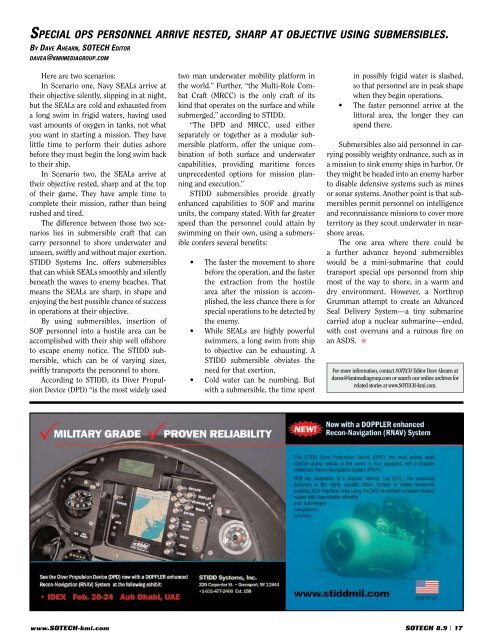Air Warrior Col. John W. Thompson - KMI Media Group
Air Warrior Col. John W. Thompson - KMI Media Group
Air Warrior Col. John W. Thompson - KMI Media Group
You also want an ePaper? Increase the reach of your titles
YUMPU automatically turns print PDFs into web optimized ePapers that Google loves.
sp e C i a l o p s p e r s o n n e l a r r i v e resteD, s H a r p a t oBjeCtive u s i n g s u B m e r s i B l e s.<br />
By Da v e aH e a r n, soteCH eD i t o r<br />
D a v e a@k m i m e D i a g r o u p.C o m<br />
Here are two scenarios:<br />
In Scenario one, Navy SEALs arrive at<br />
their objective silently, slipping in at night,<br />
but the SEALs are cold and exhausted from<br />
a long swim in frigid waters, having used<br />
vast amounts of oxygen in tanks, not what<br />
you want in starting a mission. They have<br />
little time to perform their duties ashore<br />
before they must begin the long swim back<br />
to their ship.<br />
In Scenario two, the SEALs arrive at<br />
their objective rested, sharp and at the top<br />
of their game. They have ample time to<br />
complete their mission, rather than being<br />
rushed and tired.<br />
The difference between those two scenarios<br />
lies in submersible craft that can<br />
carry personnel to shore underwater and<br />
unseen, swiftly and without major exertion.<br />
STIDD Systems Inc. offers submersibles<br />
that can whisk SEALs smoothly and silently<br />
beneath the waves to enemy beaches. That<br />
means the SEALs are sharp, in shape and<br />
enjoying the best possible chance of success<br />
in operations at their objective.<br />
By using submersibles, insertion of<br />
SOF personnel into a hostile area can be<br />
accomplished with their ship well offshore<br />
to escape enemy notice. The STIDD submersible,<br />
which can be of varying sizes,<br />
swiftly transports the personnel to shore.<br />
According to STIDD, its Diver Propulsion<br />
Device (DPD) “is the most widely used<br />
two man underwater mobility platform in<br />
the world.” Further, “the Multi-Role Combat<br />
Craft (MRCC) is the only craft of its<br />
kind that operates on the surface and while<br />
submerged,” according to STIDD.<br />
“The DPD and MRCC, used either<br />
separately or together as a modular submersible<br />
platform, offer the unique combination<br />
of both surface and underwater<br />
capabilities, providing maritime forces<br />
unprecedented options for mission planning<br />
and execution.”<br />
STIDD submersibles provide greatly<br />
enhanced capabilities to SOF and marine<br />
units, the company stated. With far greater<br />
speed than the personnel could attain by<br />
swimming on their own, using a submersible<br />
confers several benefits:<br />
•<br />
•<br />
•<br />
The faster the movement to shore<br />
before the operation, and the faster<br />
the extraction from the hostile<br />
area after the mission is accomplished,<br />
the less chance there is for<br />
special operations to be detected by<br />
the enemy.<br />
While SEALs are highly powerful<br />
swimmers, a long swim from ship<br />
to objective can be exhausting. A<br />
STIDD submersible obviates the<br />
need for that exertion.<br />
<strong>Col</strong>d water can be numbing. But<br />
with a submersible, the time spent<br />
•<br />
in possibly frigid water is slashed,<br />
so that personnel are in peak shape<br />
when they begin operations.<br />
The faster personnel arrive at the<br />
littoral area, the longer they can<br />
spend there.<br />
Submersibles also aid personnel in carrying<br />
possibly weighty ordnance, such as in<br />
a mission to sink enemy ships in harbor. Or<br />
they might be headed into an enemy harbor<br />
to disable defensive systems such as mines<br />
or sonar systems. Another point is that submersibles<br />
permit personnel on intelligence<br />
and reconnaissance missions to cover more<br />
territory as they scout underwater in nearshore<br />
areas.<br />
The one area where there could be<br />
a further advance beyond submersibles<br />
would be a mini-submarine that could<br />
transport special ops personnel from ship<br />
most of the way to shore, in a warm and<br />
dry environment. However, a Northrop<br />
Grumman attempt to create an Advanced<br />
Seal Delivery System—a tiny submarine<br />
carried atop a nuclear submarine—ended,<br />
with cost overruns and a ruinous fire on<br />
an ASDS. O<br />
For more information, contact SOTECH Editor Dave Ahearn at<br />
davea@kmimediagroup.com or search our online archives for<br />
related stories at www.SOTECH-kmi.com.<br />
www.SOTECH-kmi.com SOTECH 8.9 | 17
















